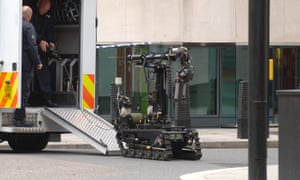Police’s
lethal use of bomb-disposal robot in Thursday’s ambush worries legal
experts who say it creates gray area in use of deadly force by law
enforcement
 |
| Bomb-disposal robots such as the one seen here have been used by the military as a weapon, according to Peter Singer of the New America Foundation, but never before by police. Photograph: Martin Godwin for the Guardian |
“We saw no other option but to use our bomb robot and place a device
on its extension for it to detonate where the suspect was,” Dallas
police chief David Brown told reporters.
Peter Singer, a strategist and senior fellow at the New America
Foundation who writes about the technology of warfare, said he believed
this was a first. “There may be some story that comes along, but I’d
think I’d have heard of it,” he said.
Others concurred. “As far as I know, it appears to be the first
intentional use of a lethally armed robot by the police in the United
States,” said Elizabeth Joh, law professor at the University of
California at Davis.
This is not the first time a robot designed with other functions in
mind has been used as a weapon, but this kind of repurposing has until
now been limited to the military. Singer said that in the early 2000s, a
solider he interviewed repurposed a surveillance robot called a Marcbot
with a bomb. These robots aren’t autonomous, Singer emphasized – the
Marcbot “is like a toy truck with a sensor and camera mount they’d use
to drive up to a checkpoint”. But this soldier had improvised: “They
duct-taped an explosive and you can figure out the rest. You can see the
parallels here.”
Singer also said that he was “in no way, shape or form condemning”
the DPD’s decision. Brown said the decision protected police officers on
a night when their lives were at greater risk than usual. “Other
options would have exposed our officers in grave danger,” Singer said.
Joh said she was worried that the decision by police to use robots to
end lives had been arrived at far too casually. “Lethally armed police
robots raise all sorts of new legal, ethical, and technical questions we
haven’t decided upon in any systematic way,” she said. “Under federal
constitutional law, excessive-force claims against the police are
governed by the fourth amendment. But we typically examine deadly force
by the police in terms of an immediate threat to the officer or others.
It’s not clear how we should apply that if the threat is to a robot –
and the police may be far away.” That, Joh added, is only one condition
for the use of lethal force. “In other words, I don’t think we have a
framework for deciding objectively reasonable robotic force. And we need
to develop regulations and policies now, because this surely won’t be
the last instance we see police robots.”
The “bomb robot” used is assumed to be the DPD’s bomb-disposal unit, a
wheeled, remote-controlled (as opposed to autonomous) robot with a
manipulator arm on top. “When there’s a suspected explosive device, a
suspected IED, you have this device with a robotic arm and a gripper on
it,” Singer explained. “You might use the device to open up a bag and
see if there’s a bomb in it. You might use the gripper to disassemble
the device in the classic Hollywood movie cut-the-wire way; you might
shoot high-pressure water into it, and you might do a controlled
detonation.”
That, Singer said, is why the department had explosives handy –
sometimes the preferred way to deal with a bomb is to evacuate the area
around it and use another bomb to blow it up.
Similar robots were used in the DPD’s showdown with a gunman who assaulted the department’s headquarters with guns and bombs almost exactly a year ago.
On the military side, such improvisations are both the solution and,
increasingly, the problem. “We’ve seen insurgents improvise,” Singer
said. “Literally this week, the Joint Improvised-Threat Defeat Agency
[an agency within the Department of Defense whose purpose is to develop
better ways for the military to respond to IEDs] got a $20m grant to
defeat drone IEDs, not for missiles but for small commercial drones that
you and I could buy, which are used by Isis for both surveillance and
for explosive delivery.
“Technology is a tool,” Singer said. “Tools are used the way they’re
designed, and then people improvise and find new uses for them.”


0 comments:
Post a Comment
PLEASE BE POLITE